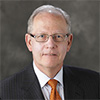Download PDF

By David W. Parke II, MD, Executive Vice President/CEO
Like many Americans, I watched this year’s World Cup with a much greater level of interest than ever before. It was difficult to ignore the passion and intensity of the international fans. Their issues became my issues: Would Messi pull it out with a final direct free kick? And there must be a better way to decide a game than a penalty shootout!
This congruence of issues is reflective of global ophthalmology, in keeping with its worldwide roots: The earliest discoveries came from the Middle East, Greece, and India; scientific developments spread over time and distance to prominent centers in Europe in the early 20th century. After World War II, the United States became an increasingly important contributor.
Now, ophthalmology is a truly global community. Over half of the submissions to Ophthalmology come from outside the United States. Over 25 percent of Academy members practice internationally, and nearly 30 percent of ophthalmologists at AAO 2014 in Chicago will carry non-U.S. passports. Increasingly, their issues are our issues and vice versa.
Academy leadership meets regularly with leadership in other national and supranational ophthalmology societies. Although these societies differ in size and resources, they share similar concerns. These include educational technology and certification, regulatory constraints on new technology and drugs, patient access to care, optometry scope-of-practice initiatives, standards of care, and national imperatives for controlling eye care costs.
For example, we’ve discussed scope-of-practice issues with societies from Austria, the Netherlands, South Africa, Brazil, and Canada, as well as society-developed (not government-developed) eye care standards with leadership from China, Romania, Turkey, Kuwait, and the Philippines. Through these and many other efforts, the American Academy of Ophthalmology can bring greater value to members around the globe than ever before.
Last fall, the Academy surveyed both international and domestic members. Here are a few key findings:
- Location of international members: Europe, 36 percent; the Americas (outside the U.S.), 25 percent; Asia/Pacific region, 19 percent; North Africa and the Middle East, 8 percent; and sub-Saharan Africa, 2 percent.
- 76 percent of international members are male, and the mean age is 51. Like their U.S. counterparts, international residents in training include an increasing percentage of women (43 percent).
- 92 percent are “extremely” or “very” satisfied with their career choice, and 82 percent would recommend ophthalmology as a career. Comparable figures for U.S. members are 88 percent and 64 percent, respectively.
- 84 percent are “extremely” or “very” satisfied with the Academy. This level has been climbing since 2003.
- 98 percent of international members have used the Academy website, primarily to access its educational content.
- The annual meeting is ranked by nearly 90 percent of respondents as one of the top two international meetings. The next highest ophthalmology meeting so ranked is at 26 percent.
We are proud that nearly 9,000 international leaders in ophthalmology value their connection with American ophthalmology and the Academy. And we are dedicated to meeting the needs of the profession—regardless of your passport.